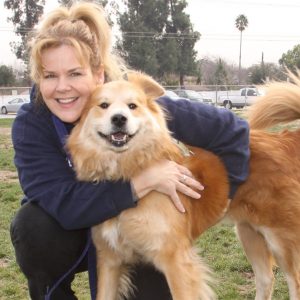 At age 15 years, 2 months and 15 days (that’s about 95 in human years1), I could not feel more blessed about the time I’ve shared on this earth with my best pal, Haiku the Chikita (Chow-Akita mix)! This bundle of fluff with almond-shaped eyes came into our lives when only 6-weeks old, so we’ve spent more than 15-years together! In that time, we have grown together and created a life-time bond.
At age 15 years, 2 months and 15 days (that’s about 95 in human years1), I could not feel more blessed about the time I’ve shared on this earth with my best pal, Haiku the Chikita (Chow-Akita mix)! This bundle of fluff with almond-shaped eyes came into our lives when only 6-weeks old, so we’ve spent more than 15-years together! In that time, we have grown together and created a life-time bond.
Prior to this moment in time, my husband and I usually adopted senior dogs, but having lost several over an 11-month period, the rescue I volunteered at encouraged me to care for this young pup, knowing good and well that we would become inseparable. How right they were! Found wandering the California desert, Hi-Coo (we later changed the spelling to the word for a 3-line Japanese poem), must have been scrappy to survive coyotes, crows and rattlesnakes in the July heat. Lancaster Animal Control, part of Los Angeles County Animal Services, placed the pup in a kennel with a litter of mixed breeds until the Director of an Akita Rescue, bailed him out and placed him in my hands.
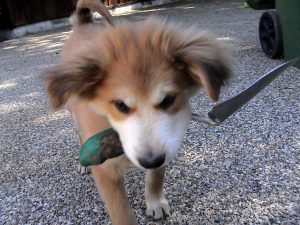
Since Haiku was the first young dog I had cared for in several decades, I realized I had been offered the gift of helping him live his best life by encouraging his exuberant personality to shine. Enriching his life with a vast array of experiences, nourished our connection and created the bond of a lifetime. My first step however, was to move beyond my human brain and truly understand what is important to the canine species: his different priorities and uses for his 5 senses and his basic instincts.
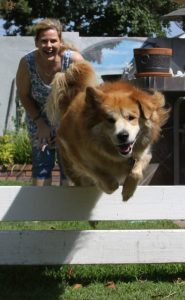
Exercise & Manners Lead to Exploration
The journey began with helping Haiku to become a well-behaved family member. Numerous articles² on the web spell out negative behaviors that a lack of exercise can lead to:
- Destructive chewing, digging or scratching
- Investigative behaviors, like garbage raiding
- Hyperactivity, excitability and night-time activity
- Unruliness, knocking over furniture and jumping up on people
- Excessive predatory and social play
- Play biting and rough play
- Attention-getting behaviors like barking and whining
I learned from dog trainer and co-owner of Thank Dog! Boot Camp, Jill Bowers, that a good dog is a tired dog, and not only did I want Haiku to behave, I hoped he would be healthy and well-conditioned by physical exercise. So, at sunrise, 5-days a week, my work-out partner and I would head to Burbank’s Johnny Carson park to practice manners and get physical. Haiku’s joy for life was apparent to all, and you can see it in his smile which garnered him the “money shot” at the end of this video³ when we thank our workout partners!
In addition to sunrise activities, we were lucky to provide Haiku with a large fenced yard in which he, his brother and sister, could run to their hearts’ content, always under human supervision, just in case there was a misstep. His puppy-hood was an exciting time to observe ways in which the other canine family members molded Haiku, teaching him manners and behaviors, enriching his learning and play, and a lot about the pecking order of the pack.
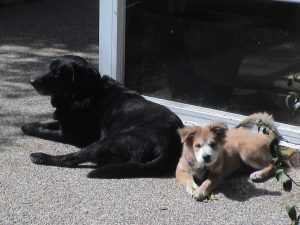
Mr. Rico (black Labrador) taught him to “raise his leg” outdoors. Haiku idolized Rico and followed him to every corner of our yard sniffing and marking. Along with playing a nurturing big sister role, I was amazed at how my Lady Bonsai (pinto Akita) took on the role of disciplinarian when Haiku’s play got too rough.
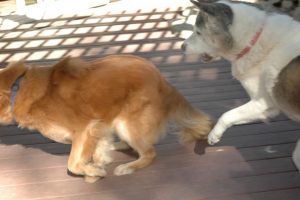
I did seek other outlets for Haiku (and all my dogs) by taking him to a variety of locales: parks, the beach, public events, and enrolling him in additional obedience training classes, 1) to socialize him to dogs outside his pack, and 2) to keep his brain sharp by reinforcing skills learned. One such training was with Sit Stay Good Dawg where my best buddy achieved his Canine Good Citizen4 status. Explains Haiku’s trainer, Cyndy Wood5, CPDT-KA, “Training enhances communication and the relationship between dogs & humans. When a dog learns their basic manners and advances learning to CGC and beyond, there are more opportunities to experience life with their human. Well trained dogs can accompany their humans to brunch at outside eating establishments, go to street fairs and enjoy hiking on public trails. ” And that is what Haiku did! Obtaining his CGC expanded my best buddy’s world and mine as together we did many things most dogs and humans don’t experience together.
Brain Stimulation
Specializing in senior dogs, I knew that early cognitive enrichment could potentially protect my best buddy from age-associated dementia. A 2019 study6 at the University of California at Davis showed signs of cognitive dysfunction in 62% of dogs age 11 and older, so I vowed to continue stimulating Haiku’s mind, along with his body. Helping his eyes, ears and nose experience as much as possible. Over the years, we refreshed obedience skills, traveled from coast-to-coast, stayed in hotels, attended conferences, dined in outdoor cafes and hiked many a trail where sniffs vastly varied. We tackled games and taste tests, and I put him, by my side, in a number of situations that challenged Haiku’s abilities to interact and behave appropriately (i.e. photo shoots, appearing at packed conventions and even on television).
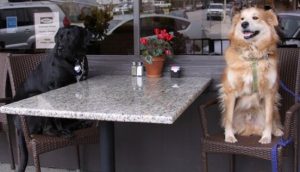
Let’s explore why this enrichment is so doggone important, and why I chose to make sure every sense my boy has – smell, see, hear, taste and touch — was stimulated.
What Zookeepers Do
Considered the gold standard in animal research, the San Diego Zoo places great emphasis on enrichment. Senior zookeeper, Kelly Murphy7 feels enrichment is key to preventing boredom in any animal, and as already cited, a bored pet will display unnatural behaviors which can be either destructive or aggressive in nature. Murphy explains, “It’s really easy for us to just give animals their food and walk away. But it’s actually been shown that if an animal is presented with food completely free with no obstacles, versus that exact same food presented in a way that requires some sort of problem-solving behavior to get at it, they will choose the harder option to use their brains.” The name for this is contrafreeloading8, and it’s something humans do as well. Most people value the stuff they work harder to obtain than those things that come easy.
Tim Sullivan9, Curator of Behavioral Husbandry at Chicago’s Brookfield Zoo, adds, “Lowland gorillas spend half their day foraging for food. Even though, in a zoo environment, we can provide all their calories in pellet form that they can ingest in 20 minutes, that doesn’t meet the animal’s behavioral needs.” Therefore, the zoo scatters and hides much of their food to encourage foraging behavior.
Dogs need this sort of activity too because behavior-based enrichment stimulates a dog’s mind and movement by piquing their curiosity. Since dogs live a cushy life with their humans in a sort of ‘captivity,’ it is important for us to recreate experiences a wild dog, free of limitations, might experience and to an environment that resembles what his brain, muscles and senses were originally designed for. As an example, in this video10, you can watch how Abba, the Andean Bear, pretty much destroys everything she is given. The challenge is to keep her busy with new things. That was my Haiku. I would buy the doggone cutest toys, and in a snap, the stuffed animal was disemboweled and button eyes were separated from each other however, according to the Curator at the Denver Zoo, Emily Insalaco, “It’s only enrichment if it encourages behavior.” I guess Haiku’s stuffies were sacrificed for good cause, but I did take care to observe and choose toys that could longer sustain his torment without pieces causing him harm.
That famous quote11 from William Cowper’s poem, “The Task” (1785), “Variety is the very spice of life that gives it all its flavor,” became my mantra to help Haiku flourish.
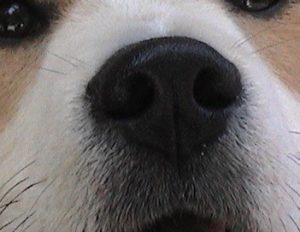 Olfactory Enrichment (The Sense of Smell)
Olfactory Enrichment (The Sense of Smell)
Deemed the most important of all canine senses, a dog’s nose is considered the gateway to his world. With 300 million receptors12 (humans have 5 million), a dog’s nose is 100,000 to 100,000,000 times more sensitive, and the part of the canine brain that analyzes smells is 40% larger than the comparable part of the human brain. Dogs can therefore detect scents that completely escape us. To put this in perspective, James Walker and colleagues at the Sensory Research Institute at Florida State University, devised this analogy, “Let’s suppose a dogs’ sense of smell is just 10,000 times better than ours. Comparing that to vision, what you and I see at 1/3 mile, a dog could see more than 3,000 miles away, and just as clearly.”
Norwegian dog nose expert (I bet you didn’t know there was such a thing) Dr. Frank Rosell13 is then right in saying, “A dog that has lost its sense of smell is no longer a dog.” This speaks to me in necessity of providing a multitude of sniffs in creating a full life for our canine pals.
Understanding the Uniqueness of a Dog’s Sniffer
- Side Slits allow a dog to harness his sniffing power. The front nostrils take in air while the side slits let him exhale without disturbing the scent particles he is trying to take in. The way the exhaled air swirls out, in fact helps usher new odors into the nose and allows dogs to sniff continuously. Bioengineers at Pennsylvania State University14 are working to reverse-engineer the canine nose to aid in the design of artificial noses that can potentially sniff as well as man’s (and woman’s) best friend can.
- Dogs shift from right nostril to left until they become familiar with a scent, then one nostril takes over depending on the scent. For example, the right side of the dog’s brain is associated with intense feelings, such as fear and aggression, so if your best buddy gets nervous at the vet’s office, he might shift to using just his right nostril.
- Sniffing independently from each nostril also allows a dog to zero in on where the scent is coming from.
- Dogs have a second olfactory system that humans do not. The vomeronasal organ (sometimes referred to as Jacobson’s organ) picks up pheromones.
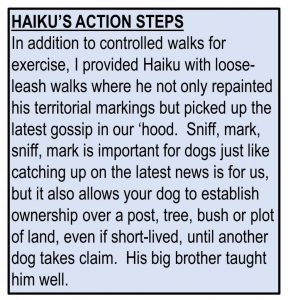
Haiku’s sniffer never failed him. When playing the “Cup Game” where I’d put a treat under one of three paper cups and swirl them around, he found the prize on the first try each time! His favorite though, was when his dad would scatter a few treats on his bed and have him enter, with lights off! Almost immediately we’d hear the crunching as he sniffed out his nighttime reward.
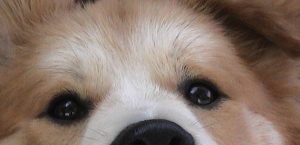 Ocular Perception (The Sense of Sight/Vision)
Ocular Perception (The Sense of Sight/Vision)
The retina collects light for the brain changing light into images our dog see. It is made of rods, which detect motion and dim light, cones, which detect color and brightness, and the tapetum lucidum which is like a mirror reflecting light.
Cones & Color – Dogs have only yellow and blue-to-ultraviolet light cones. This makes red appear green, similar to people who experience red-green colorblindness. They also cannot tell pink, orange, yellow and green apart, so buying your pooch the same toy in various colors is not as enriching as providing various types of toys.
What helps your dog muddle through less differentiation in color is that he relies more heavily on his sense of smell and hearing, so yes! Enrichment is multi-sensational! Additionally, brightness and movement override their attention to color, so if the toy moves, it is likely to be a hit, at least for a while.
Tapetum Lucidum – Our dogs’ ancestors were crepuscular, meaning they hunted during dawn and dusk when prey is active, yet light is dim. Therefore, dogs see four times better than humans in less brightness. Additionally, they have a reflective layer behind the retina. As light passes through the retina, it reflects off this tapetum before passing back through the retina allowing both rods and cones to receive even more light. The resulting reflection is what gives our pets’ eyes that glow from the flash of a camera.
Field of Vision & Motion
Our furry friends also have a wider field of vision. Most humans see 180° in front while dogs see about 240° varying by breed. Increasing their world view is the fact that animals see things more quickly. Humans, dogs and cats see in a series of very quick still photos as the retina takes a fraction of a second to receive light and translate it into an image in the brain. For us, this happens about 60 times per second, but for our pets, the processing occurs between 70 and 80 times per second, and this is why dogs rarely miss a catch. When a ball is thrown, it takes your dog a fraction of a second less to see where it is going. Flicker fusion rate15, is why some pets don’t show interest in television. They actually see the gap between images, so rather than a moving picture, TV appears like a quick slide show of still photographs to them. This perception of motion may be the single most important factor separating predators from prey. The additional rods that our pets have in their eyes allows them to spot the slightest movement, the wave of a hand a ½-mile away, for instance. Yet, sometimes they’ll miss a still object a few inches from their snout, unless the scent is intense.
The sight and sound of toys can draw out the natural behaviors of going on the hunt, chasing, and dare I say, disembowling the creature (Haiku excelled at the last part), but from what we learned above, a range of toys, not just different colors, provides the chance for your pooch to mix it up.
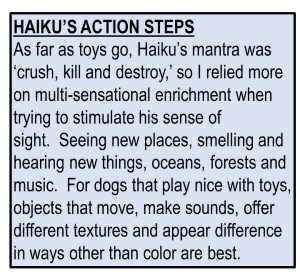
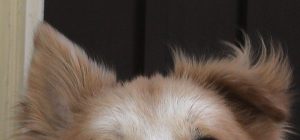 Auditory (The Sense of Hearing)
Auditory (The Sense of Hearing)
Paws down, most would rate smell as the #1 most important canine sense, but a close second may be hearing. If you could hear what your dog hears, you would have a superpower! Dogs use their ears to listen for prey and listen for danger, so it is tuned to high-pitched squeaks and rustlings. No wonder Haiku never missed the opportunity to show up in the kitchen when potato chips or candy bar wrappers are opened.

- Jack hammer hurts humans 130+db but 85+ hurts dog ears
- Barking dogs at a shelter 85-110dB
- Ultrasonic flea collar sends out pulses of sound 30-50Hz
Taking sound to a different level, really more for the human, but…allowing your dog to have control of his needs is good for mental health. A great example is to provide a bell or other noisemaker, and train your dog to ring it when he needs to answer nature’s call. You could provide different sounds for play, a toy or when doggie wants a treat. One of Haiku’s long ago brothers, Rex, excelled at bringing his dad and me the frog stuffie, the squirrel stuffie or the frisbee on command.
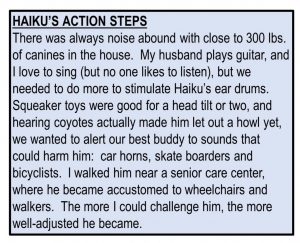
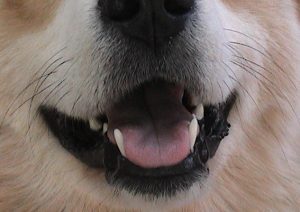 Gustation (The Sense of Taste)
Gustation (The Sense of Taste)
According to Fear Free® guru, Dr Marty Becker17 , “There is no more noticeable sign of a happy dog than a wagging tail, but there’s no better way to get that dog to wag than to open a bag of treats!” A symbiotic relationship exists between the mouth and the tail! Shares Becker, “When I first started Fear Free®, we had a rookie’s pantry of only freeze-dried liver and Honey Nut Cheerios. Now, we have a super power pantry with deli meats, cheeses (including cheez wiz), Fruit Loops and several other sweet breakfast cereals, various freeze-dried meats, Begg’n Strips, baby food, turkey hot dogs, probably five kinds of squeezables, even cat treats for dogs, as well as various canned and moist foods. Whatever will make them wag.”
Even though a dog’s sense of taste is 1/6 as discriminating as a human’s (they have 1,700 to our 9,000 taste buds), dogs have other unique tasting features we do not. Dogs experience the same four classifications18: sweet, sour, salty and bitter, but they also have taste buds for water. Found at the tip of the tongue, these buds are more sensitive after eating salty and sugary foods. Since their ancestors’ palate experienced 80% meat in the wild, dogs surprisingly do not have an affinity for salt. Sour and bitter equates to rancid or poison, so could be life-saving, but dogs have developed a liking for sweet flavors as omnivores from the fruits and vegetables they scavenged. So why will they graze the garbage or your cat’s litterbox? Smell! Smell and taste are closed connected and dogs can taste food through their palate. The stronger the smell, the more interesting. Oddly, they cannot differentiate between, beef, chicken, pork, or fish without using their nose!
Something I did not try with Haiku, due to our need of working on resource guarding when he had a brother and sister, was to make feeding more challenging by placing his bowl in different locations every day. For some pets, that can add to mealtime fun.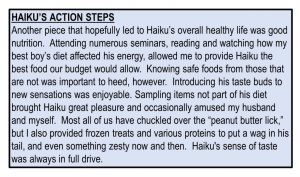
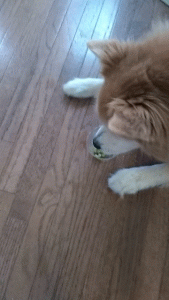
Honestly, the only thing he ever rejected was raw cauliflower! Someday, in the future*, just before it is time for Haiku to receive his angel wings and halo, I plan to bring a last moment of joy by sharing the forbidden taste of chocolate!
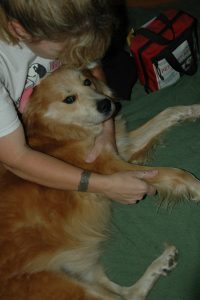
Tactile (The Sense of Touch)
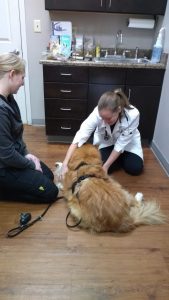
Touch is the first sense to develop19 and, during your pup’s first few weeks of life, it is the sense he relies on and learns from most. Touch speaks to both your dog touching objects and how he is touched by others. Covered in sensitive nerve endings, the canine body can feel the world around him: a fly landing on his back, the wind rustling his fur, a too hard nip from a litter mate and the human touch.
It took Haiku well into his golden years to settle enough to enjoy the feel of a massage. Belly rubs though, were always a favorite, only treats were more coveted. Brushing away loose hair also stimulates oil glands, so grooming is enrichment. Along with hearing, many experts believe that tough is the last sense to leave our canine best friends, so no matter how difficult, be there for your beloved pal’s final journey. Let your voice be the last he hears and your gentle, loving touch, the last thing he feels.
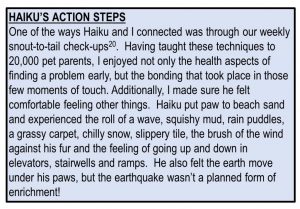
Action Steps for Your Dog
Shelters too, have discovered the role enrichment can play in making dogs easier to adopt21, but as you develop your plan for your best pal, keep just two specific things to keep in mind:
- Obedience Training not only keeps the mind sharp but prepares your pup to go where other dogs may not have gone before, and…
- The World is Your Oyster! You and your dog can achieve anything you wish. Enrichment does not take a lot of time or money, just a willingness to get creative.
Many of the tips you’ll find in the chart below are easy breezy and inexpensive. Mix it up and get a little of the wild back in your pooch! Let him experience the thrill of tracking prey (even if it’s stuffed), the excitement of finding hidden treats22 and the satisfaction of a doggie nap to recover from all the exertion.
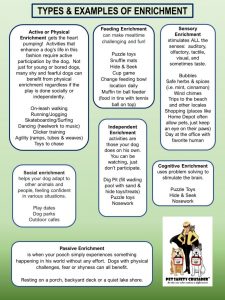
Summary
Enrichment does way more than alleviate boredom. I know the time Haiku and I have spent together travelling, learning, exploring and challenging, has created a bond that will last beyond his lifetime. Haiku has truly lived his canine life to the fullest: dipping paws in both the Atlantic and Pacific Oceans, scenting in 14 U.S. states, indulging in room service from Pacific Palisades to Myrtle Beach, and helping his mom demonstrate pet first aid techniques at conferences, on television and for magazine photo shoots (where on occasion, he was reminded of his manners) as well as serving as product tester for my blog. Haiku had his picture taken by Lassie’s Star on the Walk of Fame and in front of the Hollywood Sign. He explored the ‘bat caves’ made famous in the 1960s “Batman” TV Show, and wet his whistle in the famous Cafe Lafitte in Exile after a long walk through New Orleans’ French Quarter. Foremost, Haiku got to be a dog, running, playing, eating, resting, chasing, barking and yes, pooping. 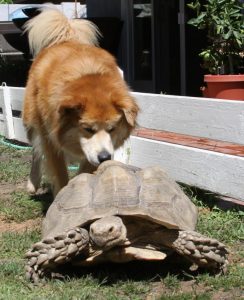 He met other creatures along the way: horses, a tortoise, an owl, bunnies, cats, crows and a rattlesnake up close (but not too close like his sister did) and had the joy of being the baby brother to two older canines. He seemed to flourish in later years being doted upon as the only child, so enrichment came in many forms, each experience connecting us more deeply. I strongly feel that seeing sights, tasting flavors, sniffing scents and other ongoing mental stimulation was key to my best buddy remaining in the moment these 15+ years.
He met other creatures along the way: horses, a tortoise, an owl, bunnies, cats, crows and a rattlesnake up close (but not too close like his sister did) and had the joy of being the baby brother to two older canines. He seemed to flourish in later years being doted upon as the only child, so enrichment came in many forms, each experience connecting us more deeply. I strongly feel that seeing sights, tasting flavors, sniffing scents and other ongoing mental stimulation was key to my best buddy remaining in the moment these 15+ years.

Of course, I keep in touch with and am forever grateful to that wonderful Wendy Schmerse22, who first placed Haiku in my hands, and recently said, “I remember how tiny Haiku was. He had so much energy, and I wanted him to have the best life. I believe he did that with Paul and you.”
A highlight that melted my heart, occurred at an outdoor restaurant during Haiku’s first stay at a hotel. A young boy came up to my best buddy asking if he could pet him. When I responded in the affirmative, the boy touched Haiku’s soft fur and exclaimed, “He’s my dream come true.” What an incredible thing for anyone to say about another being! Nothing could make me prouder of giving my best buddy a life well lived, and I hope all of you will find that by enriching your dog’s life, you will discover your own life has been enriched as well.
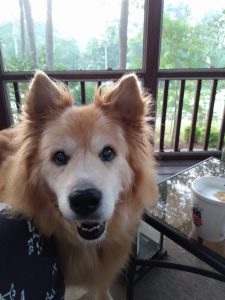
*AUTHOR’S NOTE: My precious baby boy received his angel wings and halo only two days after this post first appeared. On August 31st, 2020, not only were the last faces Haiku saw mine and his dad’s, but our voices too, whispering our thanks for all the love and memories made together, and YES! Haiku did voraciously gobble two pieces of forbidden chocolate before we bid him adieu. I miss him terribly, but hope he’s getting plenty of belly rubs and pumpkin cookies wherever he is, until I can once again provide those things for him along with a great big kiss on his nose. That amazing bundle of fur is forever in my heart and made my life richer by being in it!
Footnotes
1 American Kennel Club Staff, How to Calculate Dog Years to Human Years, November 20, 2019.
² KanineFit, Problems with Lack of Exercise or Running.
³ MSNBC Wellness, Thank Dog! Bootcamp episode, October 21, 2010.
4 American Kennel Club, What is Canine Good Citizen?
5 Cyndy Wood, personal interview, August 29, 2020.
6 Maxxipaws, Canine Cognitive Dysfunction Syndrome.
7 San Diego Union-Tribune, Zoos Entertain Visitors, Now They Also Entertain Their Animals, Bradley J. Fikes, February 18, 2018.
8 The Audiopedia, Contrafreeloading, February 1, 2018.
9 Fear Free Happy Homes, How to Think Like a Zookeeper About Your Pet’s Welfare, Linda Lombardi, July 6, 2020.
10 The San Diego Union-Tribune, Making the Animals Feel at Home, September 7, 2019.
11 Dictionary.com.
12 University of Chicago Press, Secrets of the Snout: The Dog’s Incredible Nose, Frank Rosell, , April 2018.
13 Psychology Today, Secrets of the Snout: A Dog’s Nose is a Work of Art, Marc Beckoff, PhD, April 6, 2018.
14 NOVA, Tyson, Peter, Dog’s Dazzling Sense of Smell, October 4, 2012.
15 Herbsmith staff, The Eyes of a Dog.
16 Petful, How Do Dogs Hear So Well?, Dr. Pippa Elliott, BVMS, MRCVS, June 4, 2019.
17 Dr. Marty Becker, personal interview, August 2018.
18 American Kennel Club, Finlay, Katie, Can Dogs Taste?, March 17, 2017.
19 The Doginton Post, Understanding Your Dog’s (Amazing) 5 Senses, Brandy Arnold, January 26, 2020
20 PetFirst Pet Insurance, Get to Know Your Pet From Snout-to-Tail, Denise Fleck, August 2019.
21 The Dog People, Life-Saving Enrichment Helps These Untouchable Shelter Dogs, and Its Good For Your Dog Too, Shoshi Parks.
22 Science Direct, Neurobiology of Aging, Learning Ability in Aged Beagle Dogs is Preserved by Behavioral Enrichment and Dietary Fortification: a two-year longitudinal study, N.W.MilgramaE.HeadbS.C.ZickercC.J.Ikeda-DouglasaH.MurpheydB.MuggenburgdC.SiwakaD.TappaC.W.Cotmanb, January 2005.
23 Wendy Schmerse, personal interview, August 29, 2020.









